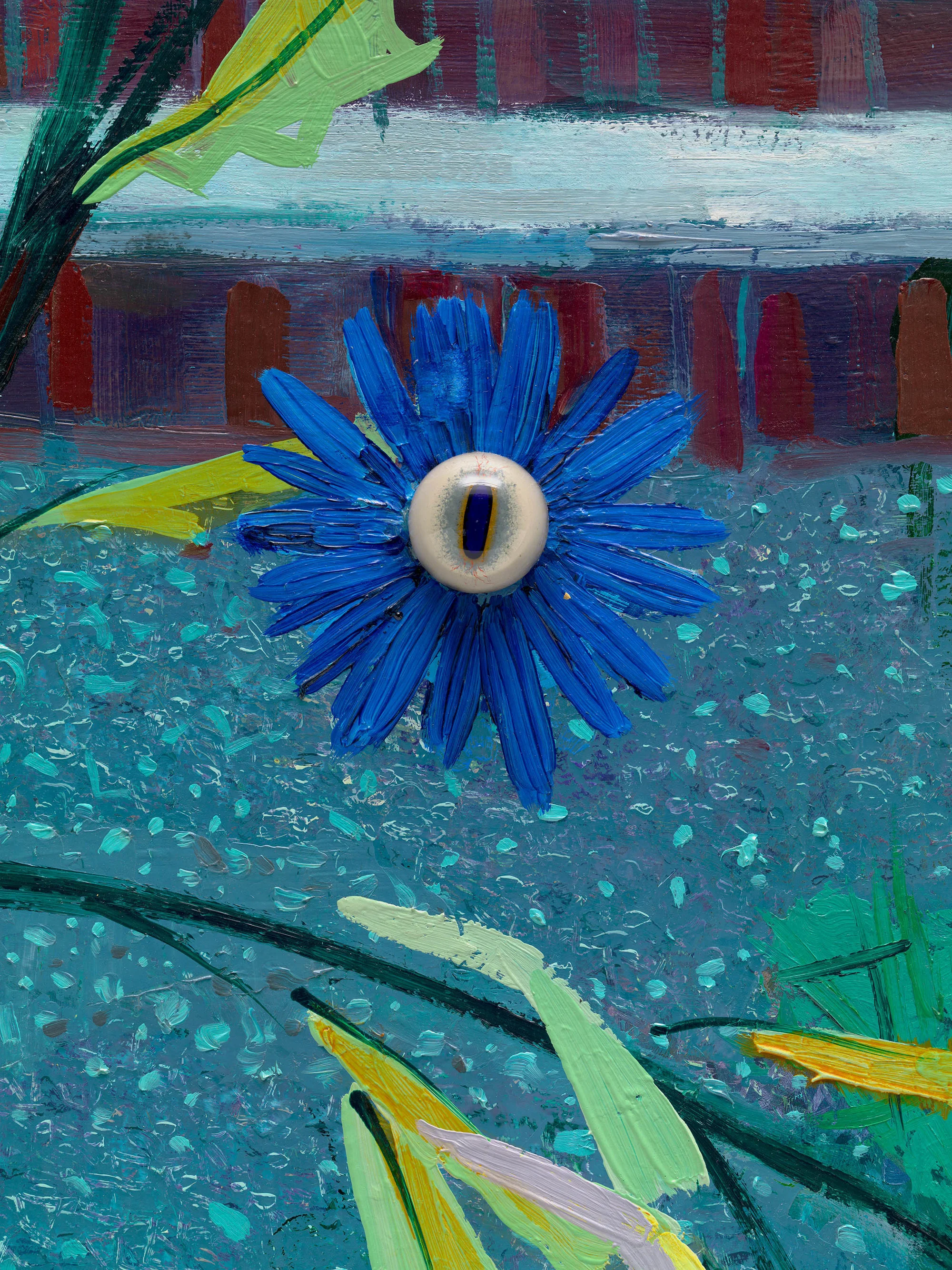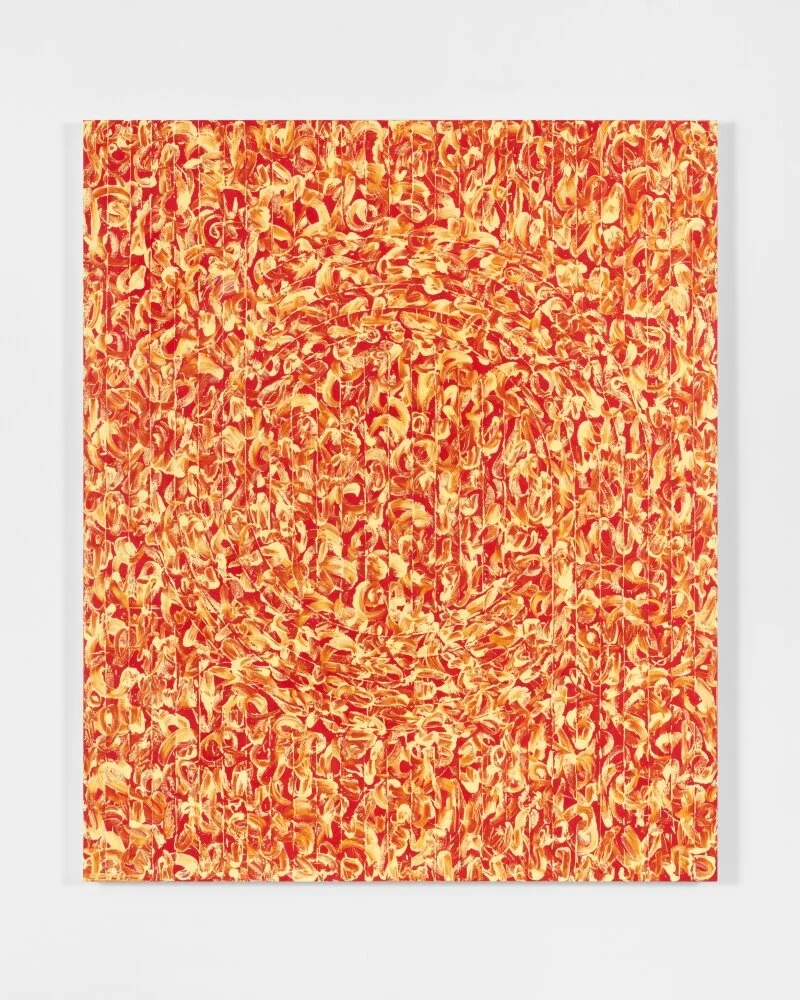Frank Moore
“More Life”
New York, 525 West 19th Street
An essayist with a brush, Moore connected complex ideas in his works and illustrated a polymathic desire to elucidate the wonder and anguish of the world around him. He turned to painting as his primary form of expression in the late 1980s, considering it 'an intensely sensual activity' that occupied both a limitless and bounded space: 'When a painting is activated, my universe seems to cease at the framing edge.'1 Moore committed himself to a rigorous research-based studio practice that resulted in exquisitely rich allegories of contemporary queer life and fabulist modes of self-portraiture.
Using a variety of unorthodox application tools and brilliant pigments, Moore created seductive, scenographic compositions that were informed by his extensive studies in art history, philosophy, science, and spirituality. He alternately repurposed found frames or elaborately constructed his own that incorporated the trappings of his personal life or elements from his myriad inspirations. These complete metaphysical realms are often characterised by conflicting emotions: rage and humour, desire and neglect, love and grief. For him, painting was a way to both convey earthly pleasures and understand overwhelming ecological concerns such as the toxic impacts of fossil fuel usage, genetic engineering, industrial food systems, and the pharmaceutical industry's grip on antiretroviral drugs. The themes with which Moore presciently wrestled continue to reverberate to this day. As the artist observed, 'You cannot have healthy people in an unhealthy environment, and you can't have a healthy environment where unhealthy—greedy, exploitative—people predominate.'2
A painting by Frank Moore, titled Lullaby II, dated 1997
Though he initially pursued abstraction, Moore, with Boschian detail, turned to incandescent, image-focused compositions that generously encompass the numerous subjects that preoccupied him, portraying entire ecosystems within a frame. His pictorial references include but are not limited to classical iconography, the Italian Renaissance, Hudson River school landscapes, Norman Rockwell's illustrations, New York's downtown theatre and performance scenes, and the work of twentieth- and twenty-first-century painters as diverse as Florine Stettheimer, Alberto Savinio, Paul Cadmus, Peter Blume, Barnett Newman, Brice Marden, and Kerry James Marshall. He also depicted his fascination with the natural world and alluded to the invasive aspects of the biotechnologies that were keeping him and others who were diagnosed HIV-positive alive. In the words of the exhibition curator Hilton Als, '[Moore]'s singularity as an artist rests in his ability to visualize anxiety and love in equal measure. His minute, detail-oriented paintings are an exploration of transformation—what happens to bodies, people, under duress.'3
Frank Moore is a part of More Life, a focused series of curated solo exhibitions presented on the fortieth anniversary of the ongoing HIV/AIDS crisis. For more information, please visit davidzwirner.com.
Born in New York City in 1953, Frank Moore spent his childhood on Long Island and summered with his family in the Adirondacks, where he initiated a lifelong interest in nature and was exposed to Works Progress Administration–era artists. From 1971 to 1975, he studied painting and psychology at Yale University and completed a residency at the Skowhegan School of Painting and Sculpture in 1973. He variously lived in New York and travelled abroad through the 1970s, studying decorative arts, and began working in the theatre and performance scenes from 1980 onward. He collaborated with the choreographer Jim Self on the costume and set design for the Bessie Award–winning experimental film Beehive from 1985 to 1987.
Moore was diagnosed HIV-positive in 1987. After his partner, Robert Fulps, died in 1991, Moore joined Visual AIDS and helped design the internationally recognized looped red ribbon that continues to raise public awareness of AIDS to this day. In 2002, he passed away at the age of forty-eight from AIDS-related complications.
He presented his first solo exhibition at the Clocktower Gallery, New York, in 1983. Paula Allen Gallery, New York, organised solo presentations of his work in 1988, 1989, and 1990. In 1993, he presented his first solo exhibition with Sperone Westwater, New York (subsequent solo presentations followed in 1995, 1998, and 2003). Three of Moore's paintings were included in the 1995 Whitney Biennial, curated by Klaus Kertess. He received an Academy Award in Art from the American Academy of Arts and Letters in 1999. Three years later, Sue Scott organized a midcareer retrospective devoted to Moore at the Orlando Museum of Art, Florida, that travelled to the Albright-Knox Art Gallery, Buffalo. In 2012, the Grey Art Gallery at New York University organised the comprehensive survey exhibition Toxic Beauty: The Art of Frank Moore that was paired with a smaller show at NYU's Fales Library, which houses the artist's papers.
Hilton Als became a staff writer at The New Yorker in 1994, a theatre critic in 2002, and chief theatre critic in 2013. He began contributing to the magazine in 1989, writing pieces for The Talk of the Town. Als was previously a staff writer for The Village Voice and an editor-at-large at Vibe. He has also written articles for The Nation, The Believer, The New York Review of Books, and 4Columns, among other publications. His first book, The Women, a meditation on gender, race, and personal identity, was published in 1996 (Farrar, Straus & Giroux). His most recent book, White Girls (McSweeney's), discusses various narratives around race and gender and was nominated for a 2013 National Book Critics Circle Award in Criticism.
In 1997, the New York Association of Black Journalists awarded Als first prize in both Magazine Critique/Review and Magazine Arts and Entertainment. He was awarded a Guggenheim fellowship for creative writing in 2000, the George Jean Nathan Award for Dramatic Criticism for 2002 to 2003, and a Windham-Campbell Prize for Nonfiction in 2016. In 2017, he was awarded the Pulitzer Prize for Criticism. The same year, he was the recipient of the Langston Hughes Medal. The honour celebrates writers from the African diaspora for their distinguished work. Previous honorees include James Baldwin and Toni Morrison.
In 2010, he published Justin Bond/Jackie Curtis (After Dark Publishing), his second book. In 2015, Als cocurated, with Anthony Elms, a retrospective of Christopher Knowles's work at the Institute of Contemporary Art in Philadelphia. He is also the co-author of Robert Gober: The Heart Is Not a Metaphor, the catalogue published on the occasion of Gober's retrospective at The Museum of Modern Art, New York, in 2014. In 2016, he produced a six-month survey of art and text at The Artist's Institute, New York, and organised Desdemona for Celia by Hilton, an exhibition of work by Celia Paul, at The Metropolitan Opera's Gallery Met in New York. His work was included in the group exhibition Looking Back: The Eleventh White Columns Annual in New York in 2017. The same year, Als curated the critically lauded exhibition Alice Neel, Uptown, which travelled from David Zwirner, New York, to Victoria Miro, London and Venice. In 2019, Als presented God Made My Face: A Collective Portrait of James Baldwin at David Zwirner, New York. He has curated a series of three successive exhibitions for the Yale Center for British Art, New Haven, of the work of Celia Paul (2018), Lynette Yiadom-Boakye (2019), and Njideka Akunyili Crosby (2022–2023). His exhibition She Who Is: Adrienne Kennedy and the Drama of Difference was recently on view at Artists Space, New York.
Als is an associate professor at Columbia University School of the Arts and has taught at Wesleyan University, Wellesley College, Smith College, and the Yale School of Drama. He lives in New York City.








